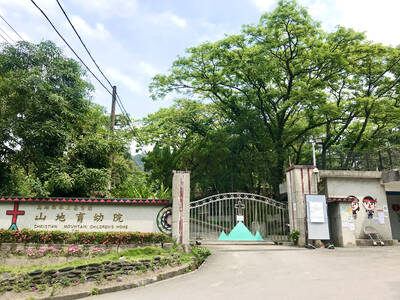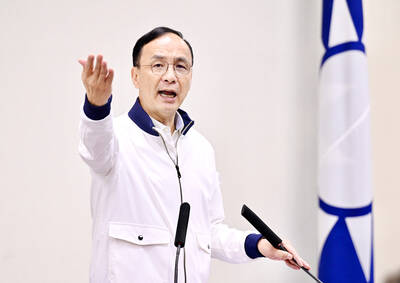A shaman blows a bull’s horn on festival day and pivots to clouds of burning incense in a purification ceremony, all shot on video.
The snapshot of native American life opens Nukanchik Yuyay, a twice-daily newscast in Quechua, the language spoken by millions of people across the Andes and enjoying a revival as even presidents take up its cause.
The program’s newscasters speak below a woolen tapestry of Cotopaxi, a glacier-capped volcano within sight of the station, Ecuador’s channel 47. Besides the station’s cameras, a wolf mask bares white fangs.
Based in Latacunga, 80km south of Quito, Channel 47 says it is the world’s first television station for Quechua speakers. On air since July, it features 30 percent Quechua programs and aims to go mostly monolingual as its audience increases.
“Our next project is Quechua cartoons ... to draw in children,” says station manager Angel Tiban.
Channel 47’s appearance is a part of broader efforts to inject new life into Quechua, repressed by late Spanish colonial powers. New constitutions in Bolivia and Ecuador, enacted under leftist presidents, enshrine Quechua as an official language, and Bolivia this year founded the first Quechua-speaking university.
In Ecuador, Rafael Correa is the nation’s first fluent Quechua-speaking president in memory.
Quechua speakers live along the Andes, from Argentina and Chile in the south to Colombia in the north, where it’s called ingano. Most are in Peru, Bolivia and Ecuador.
First spread by the Incas, Quechua expanded its reach under the Spanish who used it to spread Roman Catholicism.
For centuries, university professors taught the language at the region’s premier university, San Marcos. Quechua books and theater on Inca history flourished. But that suddenly halted and classes were banned after colonial authorities crushed an Indian rebellion in 1781 led by Jose Gabriel Condorcanqui, who adopted the name of Inca ruler Tupac Amaru.
Estimates of Quechua speakers range from 6 million to 13 million, but linguists say that even now some Andeans still won’t tell census takers they speak the language because of its long association with backwardness and low social status.
CHANGING STATUS
“Kichwa (Quechua) used to have no prestige ... If you wanted prestige, you learned English, French or German,” says linguist Jose Maldonado, a presidential adviser who provides a weekly recap in Quechua on national television of Correa’s activities.
Now, Ecuadoreans outnumber Americans in Quechua classes at Maldonado’s university and bodyguards, police and civil servants at the presidential palace are signing up for in-house classes.
With an eye on younger generations, Quechua educators and broadcasters are also seeking to promote the “cosmovision” of Indian peoples once ruled by the Incas. It invokes the intricate balance of dualities that make up the world.
“In geography, we want to teach that there are male mountains and female mountains, and sometimes a smaller mountain between is a child,” said Alberto Conejo, academic director of intercultural bilingual education at Ecuador’s education ministry. He wore a blue poncho and many bureaucrats on the high-rise floor wore traditional Indian dress.
To illustrate “cosmovision” to a recent vistor, Channel 47 manager Tiban rolled tape of a native flutist’s Quechua interview, and interpreted: “He is saying some wind pipes are masculine, others are feminine, and that they have to be in equilibrium for harmony.”
Quechua “cosmovision” dualities include hot and cold, and night and day, said Lucila Lema, a bilingual poet who until this month hosted the Quito-based Quechua newscast Kichwapi or In Quechua. It is the first national newscast of the day on an otherwise Spanish-language network RTS.
Kichwapi colleague Enrique Conejo said some terms defy easy Quechua translation: “The word inflation is a headache.” But other translations have gained traction. Kichwapi now calls a car antawa — derived from the Quechua word anta, or metal.
Quechua promoters are campaigning to turn national legislatures into bilingual bodies but the Ecuadorean bid has already met resistance, says congressman Pedro de la Cruz.
Congressional authorities told him it cost too much to pay for simultaneous interpreters and translation cabins.
As a compromise, he said, the National Assembly allows a quartet of Indian legislators to speak five minutes in Quechua on top of lawmakers’ standard 10-minute Spanish time cap.
The Web sites of Ecuador’s National Assembly and Peru’s Congress now feature extensive Quechua sections.

May 18 to May 24 Pastor Yang Hsu’s (楊煦) congregation was shocked upon seeing the land he chose to build his orphanage. It was surrounded by mountains on three sides, and the only way to access it was to cross a river by foot. The soil was poor due to runoff, and large rocks strewn across the plot prevented much from growing. In addition, there was no running water or electricity. But it was all Yang could afford. He and his Indigenous Atayal wife Lin Feng-ying (林鳳英) had already been caring for 24 orphans in their home, and they were in

On May 2, Chinese Nationalist Party (KMT) Chairman Eric Chu (朱立倫), at a meeting in support of Taipei city councilors at party headquarters, compared President William Lai (賴清德) to Hitler. Chu claimed that unlike any other democracy worldwide in history, no other leader was rooting out opposing parties like Lai and the Democratic Progressive Party (DPP). That his statements are wildly inaccurate was not the point. It was a rallying cry, not a history lesson. This was intentional to provoke the international diplomatic community into a response, which was promptly provided. Both the German and Israeli offices issued statements on Facebook

President William Lai (賴清德) yesterday delivered an address marking the first anniversary of his presidency. In the speech, Lai affirmed Taiwan’s global role in technology, trade and security. He announced economic and national security initiatives, and emphasized democratic values and cross-party cooperation. The following is the full text of his speech: Yesterday, outside of Beida Elementary School in New Taipei City’s Sanxia District (三峽), there was a major traffic accident that, sadly, claimed several lives and resulted in multiple injuries. The Executive Yuan immediately formed a task force, and last night I personally visited the victims in hospital. Central government agencies and the

Australia’s ABC last week published a piece on the recall campaign. The article emphasized the divisions in Taiwanese society and blamed the recall for worsening them. It quotes a supporter of the Taiwan People’s Party (TPP) as saying “I’m 43 years old, born and raised here, and I’ve never seen the country this divided in my entire life.” Apparently, as an adult, she slept through the post-election violence in 2000 and 2004 by the Chinese Nationalist Party (KMT), the veiled coup threats by the military when Chen Shui-bian (陳水扁) became president, the 2006 Red Shirt protests against him ginned up by